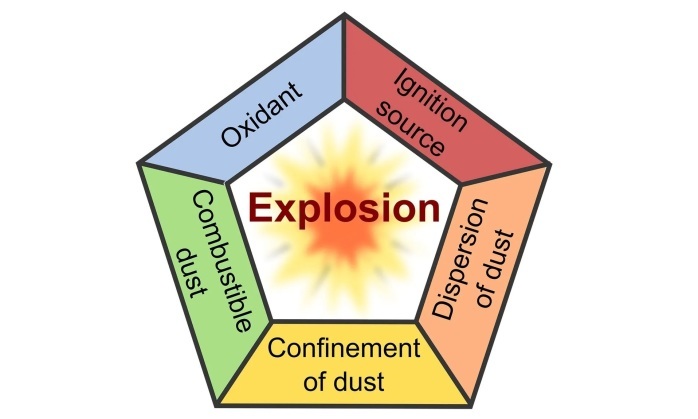Vacuums for Combustible Dusts
Vacuums and Dust Collectors for NFPA compliance and for ease of use and productivity.

Learn about the OSHA and NFPA 660 requirements
“The Great Mill Disaster” of 1878
Organic dust explosions are not new. Following 'The Great Mill Disaster' of 1878, a catastrophic grain mill explosion in Minneapolis, Minnesota, significant measures were taken to prevent similar incidents. The explosion, which destroyed the Washburn A Mill, the world’s largest grain mill, and a handful of adjacent mills, reducing the city’s milling capacity by as much as half, claimed the lives of eighteen people. This incident, blamed on an accumulation of grain dust, led to extensive discussions and initiatives to improve industrial safety and prevent the accumulation of combustible dust.
NFPA published it's first standard on combustible dust in 1923
NFPA published it's first standard on combustible dust in 1923. So this isn't a new problem. Companies have been reluctant to do anything due to perceived high costs. In almost every case it is a cost saving measure to address the hazard. We are happy to help you with the first steps.
Wet Dust Collection of Explosive Metal Powders
A wet dust collector, also known as a wet scrubber, uses water or another liquid to trap and remove dust particles from air streams, often preferred for applications involving potentially explosive or flammable materials.
Water is used to neutralize aluminum dust, where as neutralizing oil is used for titanium dust as water can be an accelerant in titanium fires.
What are some examples of explosive powders?
- food (e.g., candy, sugar, spice, starch, flour, feed)
- grain
- tobacco
- plastics, wood paper, pulp
- rubber, pesticides
- pharmaceuticals
- dyes
- coal
- metals (e.g., aluminum, chromium, iron, magnesium, and zinc).
Understanding OSHA regulations on combustible dust
Currently, there are no OSHA mandates on Combustible Dusts; there are Standards that need to be followed. Even though NFPA 660 isn't a law, you can still be held accountable for safety violations.
What is a Dust Hazard Analysis (DHA)?
A Dust Hazard Analysis (DHA), as outlined by NFPA 660, is a systematic process for identifying and evaluating fire, flash fire, and explosion hazards associated with combustible dust and particulate solids in a facility, ultimately providing recommendations to manage these risks.
The new NFPA 660 will incorporate the following standards
- NFPA 61
- NFPA 484
- NFPA 652
- NFPA 654
- NFPA 655
- NFPA 664
Click HERE for more information
What is an Explosion Proof Vacuum?
An Explosion-Proof Vacuum System is a vacuum system capable of preventing the ignition of a specified gas or vapor and operates at such an external temperature that a surrounding flammable atmosphere will not be ignited. A Nationally Recognized Testing Lab (NRTL) must certify that a vacuum system is explosion-proof.
What is an Intrinsically Safe Vacuum Cleaner?
An Intrinsically Safe Vacuum is one that operates with no moving parts and no electrical parts. The power is supplied by compressed air that is fed into a tapered restriction also called a “venturi”. Intrinsically safe vacuums are made from non-sparking metals like stainless steel and aluminum. Mild steel is not suitable as it can create a spark when a nut or a screw is vacuumed. It will create a spark when it hits the wall of the vacuum dirt-bin.
Class II, Group E Aluminum and Titanium Dust Vacuuming
NFPA 660 Chapter 8 Combustible Metals. Portable Vacuum Cleaners. The use of portable vacuum cleaners shall comply with 22.8.4.2.2. (B)*Due to the inherent hazards associated with portable electric vacuum cleaning systems, the equipment used for cleaning shall be identified for use in Class II, Group E atmosphere.
Choosing the right vacuum or dust collector
We take several factors into consideration. From the bulk density of the product being vacuumed, the Kst and Pmax values, to the electrical requirements under NEC 70. Safety as well as productivity are taken equally into consideration.
Do I need an Explosion Proof Vacuum?
If your area is HAZLOC, then yes. If you area is ORDLOC and the Kst value of the powder is low, then an NFPA 660 Compliant Vacuum is required.
Vacuums made from non-sparking materials, motors located in the clean air stream, and critical filtration are built this way to ensure a safe and productive workplace.